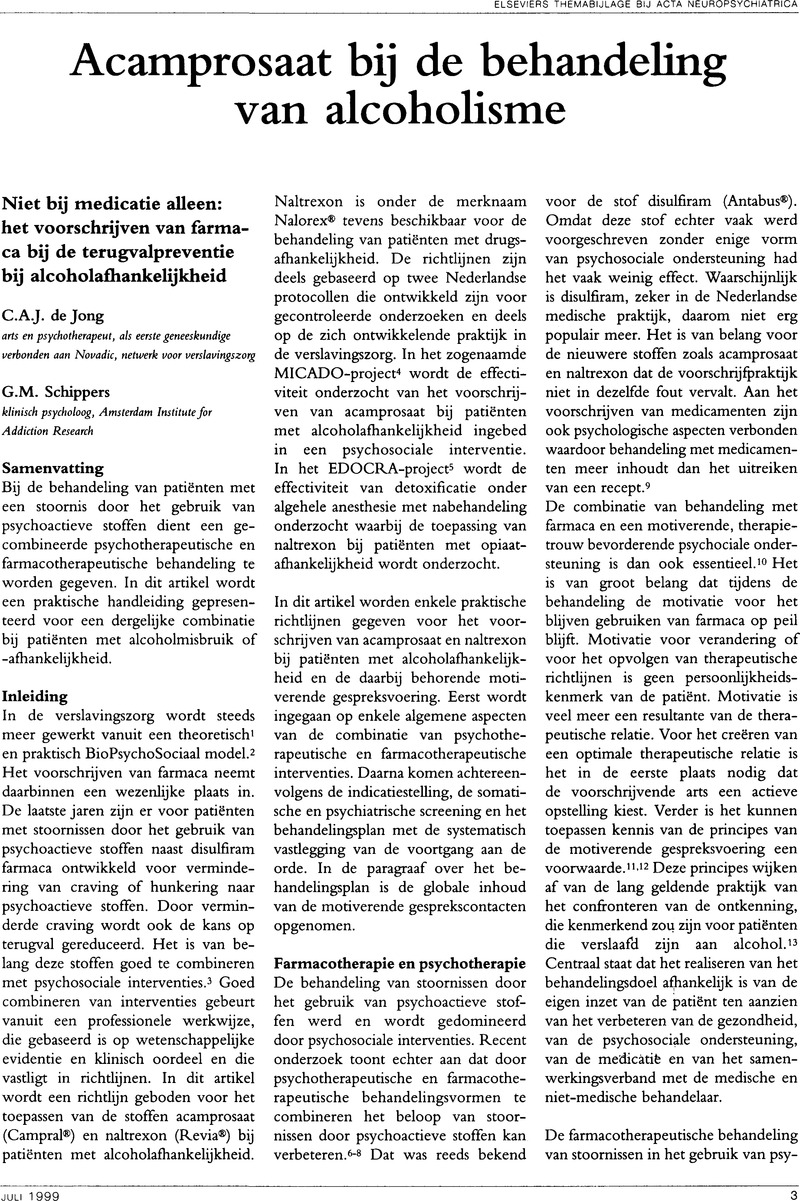No CrossRef data available.
Article contents
Niet bij medicatie alleen: het voorschrijven van farmaca bij de terugvalpreventie bij alcoholafhankelijkheid
Published online by Cambridge University Press: 18 September 2015
Abstract
An abstract is not available for this content so a preview has been provided. Please use the Get access link above for information on how to access this content.

- Type
- Acamprosaat bij de behandeling van alcoholisme
- Information
- Copyright
- Copyright © Scandinavian College of Neuropsychopharmacology 1999
References
Literatuur
1Jong, CAJ de. Het Biopsychosociale model: de theoretische basis voor de behandeling van patiënten met een dubbele diagnose. In: Weeghel, J van, Elling, A, Marek, J van der, red. Dubbele diagnose: dwalen tussen psychiatrie en verslavingszorg. Utrecht: Trimbos instituut, 1997; 17–25.Google Scholar
2Schippers, GM, Vries, MW de. Stoornissen door gebruik van alcohol en andere psychoactieve Stoffen. In: Vandereycken, W, Hoogduin, CAL, Emmelkamp, PMG, red. Handboek psychopathologie. 2e ed. Deventer: Van Loghum Slaterus; 1990, 1994: 87–106.Google Scholar
3Schippers, GM. Kortdurende intervenues bij alcoholproblemen. In: Hoes, MJAJM, Geerlings, PJ, red. Informatorium alcoholisme. Leusden: Medical Publishing, 1996.Google Scholar
6Carroll, KM. Integrating psychotherapy and pharmacotherpy to improve drug abuse outcomes. Addict Behav 1997: 22; 233–45.CrossRefGoogle Scholar
7Carroll, KM, Nich, C, Ball, SA, McCance, E, Rounsaville, BJ. Treatment of cocaine and alcoholdependance with psychotherapy and disulfiram. Addiction 1998; 93: 713–27.CrossRefGoogle Scholar
8O’Malley, S. Pharmacotherapy and psychotherapy: contradictory or complementary. Addiction 1997; 92: 950–1.CrossRefGoogle Scholar
9Jong, CAJ de. Interacties tussen arts en patient: enkele psychologische aspecten van het voor-schrijven. Patient Care 1991; 18: 80–9.Google Scholar
10Tinsley, JA, Finlayson, RE, Morse, RM. Developments in the treatment of alcoholism. Mayo clin Proc 1998; 73: 857–63.CrossRefGoogle ScholarPubMed
11Miller, WR, Rollnick, S. Motivational Interviewing: Preparing people to change addictive behavior. New York: Guilford Press, 1991.Google Scholar
12Schippen, GM. Motiverende gespreksvoering. Handboek Verslaving 1996; B4340-1-B4340-25.Google Scholar
13Miller, WR. Increasing motivation for change. In: Hester, RK, Miller, WR, red. Handbook of alcoholism treatment approaches: effective alternatives. New York: Pergamon Press, 1989; 67–80.Google Scholar
14U.K. Alcohol Forum Guidelines for the management of alcohol problems in primary care and general psychiatry. Bucks: Tangent Medical Education, 1997.Google Scholar
15Ritson, B. Pharmacotherapy in alcohol problems. Current Opinion in Psychiatry 1998; 11: 285–8.CrossRefGoogle Scholar
16Verbrugge, CAG, Jong, CAJ de. Patiënten Voorlichtingfolders voor acamprosaat, naltrexon en disulfiram. Sint Oedenrode: Novadic, 1999.Google Scholar
17Schippers, GM, Jong, CAJ de, Lehert, Ph, et al.The Obsessive Compulsive Drinking Scale: Translation into Dutch and possible modifications. Eur Addict Res 1997; 3: 116–22.CrossRefGoogle Scholar


